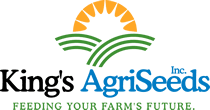Reed canarygrass is a tall-growing, perennial grass which is widely adaptable. It is particularly well adapted to wet and dry soils and soils with a pH below 6.0. However, newer varieties of reed canarygrass are equal in quality to other cool-season grasses when harvested at similar stages of maturity. Yield of reed canarygrass is closely related to the rate of N fertilization.
When using reed canarygrass for pasture, excessive forage growth must be avoided to maintain quality and palatability. Growth starts early in the spring. Maintain the grass below 12 inches tall during the rapid spring growth of May and June. Short duration rotational grazing with a heavy grazing pressure will allow the best utilization and greatest animal gains per acre. In addition, rotational grazing is recommended to allow hay harvesting of the ungrazed pastures during the spring. Reed canarygrass should not be grazed closer than 3 to 4 inches above the ground. A recovery period following grazing will also improve productivity.

